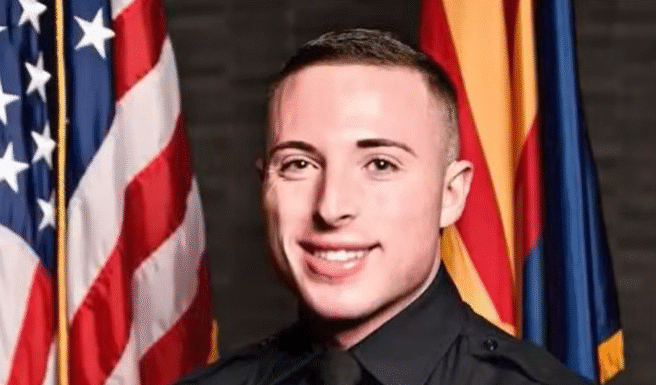Arizona Tribe Considers Banishing Violent Offenders from Community
The Gila River Indian Community, located in Arizona, is deliberating a significant policy change that could potentially banish members convicted of violent crimes from their land. This move comes amidst rising violence in the reservation, which has spurred local authorities to take aggressive steps to ensure the safety of the community.

Background and Rising Crime
The Gila River Indian Community spans over 600 square miles and has recently witnessed a surge in violent crime. The situation reached a devastating peak when Police Officer Joshua Breeze was shot and killed at an outdoor party in the summer of the previous year. The officer’s death shocked the community and prompted an outcry among residents and officials alike. His murder was a stark reminder of the growing challenges faced by the tribe.
In response to this escalating violence, Gila River Governor Stephen Roe Lewis and the tribal council enacted a series of measures to curb criminal activities. Among these was the imposition of a curfew for minors and a ban on teenage dance parties, which they hoped would help prevent further violence. Despite these efforts, crime continued to plague the reservation, prompting further action.
The Brutal Murder of Karen Peter
Tragedy struck again in April, when tribal elder Karen Peter was brutally beaten, raped, and left to die from the resulting complications. The murder of Peter further heightened tensions within the community, and many tribal members demanded justice. In connection with her death, two juveniles and an adult were arrested, but the crime had already sparked a fierce protest from the tribe’s members.
While law enforcement officials were working to hold the perpetrators accountable, Governor Lewis acknowledged the deeper issues plaguing the community. At a public gathering, he noted that the arrests, though important, would not bring back the lost lives. He reiterated the urgent need to address the rising violence, which he described as far beyond an isolated incident. His comments reflected the community’s growing frustration and demand for real change.
Calls for Stronger Action
The frustration of the Gila River residents reached a boiling point during a packed Tribal Council meeting in July, which stretched for six hours as community members voiced their concerns. At this meeting, many members demanded stronger actions to stem the tide of violence, with some urging the council to take bold steps, such as the proposed banishment of violent offenders. This demand came just days before the firing of Police Chief Jesse Crabtree, who had served for only two years before being let go. His firing was part of an internal review following the increasing dissatisfaction among the tribe’s leadership and the community.
The tribal council’s decision to fire Crabtree signified the seriousness with which they were taking the rising levels of violence. The tribe recognized the limitations of policing alone in dealing with these issues and highlighted the need for broader collaboration across the community and other departments to ensure safety. The council’s stance was clear: they were committed to enhancing public safety by taking more proactive measures.
Banishment Proposal: A First Among Indigenous Tribes
In a groundbreaking move, the Gila River Indian Community is considering a proposal to banish members convicted of serious violent crimes such as homicide, aggravated assault, kidnapping, and violent sexual offenses. This policy would be unprecedented, as no other Indigenous tribe has proposed such a measure in modern history.
The proposal for banishment has sparked significant debate within the community. Advocates believe this step could be crucial in curbing the violence and protecting the well-being of law-abiding members. They argue that violent offenders should no longer be allowed to remain within the tribe’s borders, as their actions create an unsafe environment for the rest of the community.
However, the proposal has also faced opposition. Critics raise concerns about the potential consequences of such a policy, including the risk of further dividing the community and creating a sense of exclusion. They question whether banishment is the most effective means of addressing the deeper social and economic issues contributing to the violence. Nevertheless, the Tribal Council is determined to explore all avenues in their efforts to address the violence.
Community Feedback and Survey
In an effort to gauge the opinions of the Gila River Indian Community’s members, the Tribal Council has opened a community survey, allowing residents to voice their opinions on the proposed banishment policy. The survey, originally set to close in early September, has now been extended until the 13th of the month. This extension reflects the importance the council places on ensuring that the community has ample time to provide feedback on such a transformative decision.
As of now, the fate of the proposed banishment is still uncertain, but it has ignited significant discussions about public safety, justice, and the future of the Gila River Indian Community. With the deadline for the survey approaching, the council will likely make a final decision soon.
Conclusion: A Critical Moment for the Tribe
The Gila River Indian Community finds itself at a critical juncture. The proposed banishment of violent offenders is a bold step that could reshape the future of the tribe. It is a response to the deeply felt need for safety and justice, but it is also a decision that will have long-lasting implications for the tribe’s cohesion and sense of identity.
As the community awaits the results of the survey and the council’s final decision, it remains to be seen whether this controversial proposal will gain enough support to move forward. Regardless of the outcome, one thing is clear: the tribe is committed to finding new and effective ways to combat the violence that has shaken their community. The path forward will require careful deliberation, but it may also represent a significant turning point in the tribe’s approach to justice and community safety.

